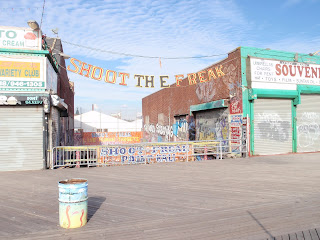Nourishment at Brighton Beach
As the N-Train weaves itself through the social topographies of Brooklyn - destination Coney Island - we are treated to what must be one of the world's longest paintings. Certainly an act of 'youthful collaboration', the artwork we will aptly refer to as "The Tag 'Scape Project" seems to be the only piece of this sub-grade exposed-to-the-sky cut through the urban landscape that is maintained. This is likely due to the MTA's perpetual efforts at "streamline costs" (echoed by an equally resounding protest of geographical discrimination). It is, again, a cool but fantastically bright sunny day and an opportune, albeit dwindling opportunity to explore one of New York's more historically celebrated cultural sites. Little did we know that the carnival began as soon as we emerged from the underground, already well into Brooklyn. A series of mostly numbered streets and avenue stops provided colourful vignettes throughout our entire "on-line" experience. As we were entertained, our anticipation built as we drew nearer the amusement destination of Coney Island.
Currently resembling more of a graveyard for rusting roller coaster rides and fading ferris wheels, Coney Island embodies an aura of nostalgia that even a newcomer can still get into. This may, in fact, be in no small part to the long-established and critically acclaimed 'Nathan's Hot Dogs' (yes, they are worth the visit). The reach of the Riegelmann Boardwalk and the unobstructed expanse of beach front that immediately captures ones attention upon arrival to the waterfront are equally matched by, and contrasted with the apparent neglect of its more colourfully random and long-running 'stage set'. Unfortunately much of what made Coney Island familiar to generations of visitors has already been torn down. We do not let this fact deter our exploration and enjoyment of this edge. The decaying and frenetic condition of this 'scape is an experience in contrasts and contradictions - an evolutionary landscape where survival of the opportunistic and 'visionary' (?) reigns.
With the beaches groomed and replenished on a regular basis by the City, Coney Island promises to live on as a destination that continues to pique interest from a lengthy list of stakeholders, investors, and tourists alike. Human targets may no longer be sought as candidates for the paintball shooting gallery ("shoot the freak"), colour may continue to fade on the storefronts revealing a decaying patina of authenticity, and the hardwood boardwalk may continue to burst its bolts. Inevitably this place's pop cultural references and accreditations will live on to see a landscape that is as sordid as its past.











